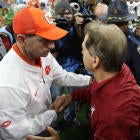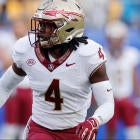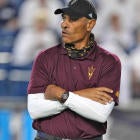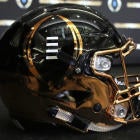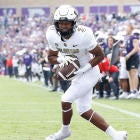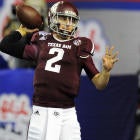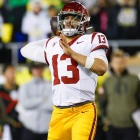The college football preseason AP Top 25 Poll was released on Monday, which is important news for two reasons. The biggest reason, at least in my mind, is that it means the season is almost here; seriously, at the end of this week, there will be teams strapping on helmets and pads and taking to the field to play games in anger. The second reason is that, meaningless as they should be, preseason polls matter.
I harp on it every year because I hate that it's true, but they do. Preseason polls set an expectation and a perception for teams -- both of which will follow the teams all season long and -- intentionally or not -- could help decide the eventual national champion. For example, if Florida loses to Miami on Saturday, it will fall from No. 8 in the next AP poll but it won't fall out of the rankings altogether even though Miami's unranked. Then, should Florida win the following week against Tennessee-Martin, it will still hover around the top 10 at 1-1 because that's where everybody already believes it belongs.
But let's say an unranked team like Georgia Tech, which didn't appear on any ballots, loses to Clemson in Week 1 and follows it up with a win over South Florida in Week 2. Georgia Tech will not appear on any ballots despite having a better theoretical loss than Florida's and a better win, as well. Why? Because everybody will still believe Florida is the much better team since they felt that from the beginning, whereas Georgia Tech will be doubted until it proves itself repeatedly.
It's just a simple fact of the sport, and whether fair, it's reality. So that's why we can call preseason polls meaningless all we want, but it doesn't make it true. So, with that in mind, here are five takeaways from the preseason AP Top 25 poll.
1. Everyone still believes it's Clemson and Alabama's world. The top 10 is identical in both the AP and Coaches polls, but there's a clear delineation between the top two and everybody else. Clemson received 99.4 percent of the 1,550 possible points in the AP poll, and 99.6 percent of the possible 1,625 points in the Coaches Poll. Alabama checked in at 96.5 percent and 96.4 percent, respectively. While the AP is higher on Georgia than the Coaches (90.5 percent to 89.0), there's still a gap between Clemson and Alabama and the rest of that top 10 that only widens the further down you go.
That's probably how it should be at this point. These are two programs that have met four times in the five-year history of the College Football Playoff, with three of those meetings in the title game. You'd have a hard time justifying putting any other program ahead of either on your ballot. At least one voter did, though, because if Alabama received 10 first-place votes and was in second place on the other 52 ballots, it would have finished with 1,498 points. It finished with 1,496.
2. The SEC is everybody's favorite conference. It's the Coaches' favorite, the media's favorite, your grandma's favorite, your dog's favorite, everybody's favorite. The Big Ten may have more overall teams in the AP poll than the SEC (seven to six), but all six of the SEC's teams are in the top 16. Only three of the Big Ten's teams are in that grouping, and one of those is Penn State at No. 15. The rest of the Big Ten is down in that "oh man, I have how many teams I still need to put on my ballot!?" territory. Of course, this also means that the SEC is still top-heavy. There were three other SEC schools to appear on ballots (Missouri finished 26th, Mississippi State 28th and South Carolina 35th), but like the Big Ten teams at the bottom of the top 25, those are mostly projection picks than ones based on performance.
But, as I wrote in the intro, this is a side effect of the SEC typically getting a larger benefit of the doubt in the minds of voters. Missouri, Mississippi State and South Carolina went a combined 23-16 last season, which is respectable enough. But those first two are both replacing multiple-year starters at quarterback, and while each is replacing them with grad transfers, I'm not sure ACC, Big 12 or Pac-12 schools with identical situations would receive the same level of optimism.
3. Nobody knows what to do with the Pac-12. As in the Coaches Poll before it, we see that once voters finished putting together their top 10, they all had a collective moment of "oh crap, I haven't put a Pac-12 team on my ballot yet." They then spun the Pac-12 Wheel of Destiny to determine which order they should put Oregon, Utah and Washington in. The AP voters landed on Oregon more often than the coaches did, putting the Ducks at No. 11 with Washington at No. 13 and Utah at No. 14. Texas A&M settled between them. In the Coaches Poll, it was No. 12 Washington, No. 13 Oregon and No. 15 Utah.
This is a problem the Pac-12 faces due to its lack of a dominant team. The one program that has long been the shining beacon of the conference, USC, received one point. That means, of the 62 voters in the AP Poll, only one felt compelled to put USC on their ballot, and they did so at No. 25. This is in stark contrast to the 47 points USC received in the Coaches Poll, so the media is far more skeptical of the Trojans, which will have an impact on the conference's playoff hopes. The Pac-12 can't afford to have a dormant USC and three teams the media likes but remains unsure of if it wants to get to the playoff. Simply put, one of those three need to pull away from the pack, and if USC wouldn't mind picking itself up and dusting itself off, the conference would be all the better for that.
4. The media really believes in Nebraska. The Cornhuskers just missed the cut in the Coaches Poll but crept into the AP Top 25 at No. 24, which tells me that the media is buying into the hype surrounding the program and Scott Frost right now. I can't question them for it, either, because while I'm not a voter and wouldn't have had Nebraska in my preseason poll, I'm not exactly a non-believer, either.
Still, that said, Nebraska went 4-8 last season. Since firing Bo Pelini following a 9-4 season in 2013, the Cornhuskers are 23-27. Now, would Nebraska appear in preseason AP poll if it were in the same situation but was Purdue or Kansas State or Boston College?
5. The Group of Five barely exists. Speaking of Frost, his old team starts the season at No. 17 in the AP poll, just seven spots higher than his current team. UCF is the only Group of Five to appear in the AP poll, and all it had to do to get there was go 25-1 the last two seasons; though I suppose that's a step in the right direction for UCF. After all, it began last season at No. 21 in the AP poll despite going 13-0 the year before and beating Auburn in a bowl game.
But this is about more than UCF. The Knights are the only Group of Five team to make the top 25, while other programs like Army, Boise State, Cincinnati, Fresno State, Utah State, Memphis, Appalachian State and UAB all reside in Others Receiving Votes territory. Of those eight G5 teams I just listed, only Memphis failed to win at least 10 games last season. Meanwhile, 4-8 Nebraska starts the season at No. 24.
I don't mean to pick on Nebraska. I fully expect the Cornhuskers to be a better team than at least half of those squads in 2019, so I get it. I'm just using this an example to show the kind of bias Group of Five teams have to overcome even to have a shot. The Power Five conferences are better than the Group of Five conferences, but the gap between them is never as enormous as preseason polls would have you believe.












